{{currentView.title}}
April 14, 2023
Salafi-Jihadi Movement Weekly Update, April 12, 2023
To receive the Salafi-Jihadi Movement Weekly Update via email, please subscribe here. Follow CTP on Twitter, LinkedIn, and Facebook.
Data Cutoff: April 12, 2023, at 10 a.m.
Key Takeaways:
Iraq and Syria. ISIS is executing a decentralized military campaign in northeastern Syria to destabilize the Syrian Democratic Forces (SDF). ISIS strategic communications provide guidance for operational and tactical commanders implementing the campaign. ISIS’s campaign design assumes military success will gain the support of local populations by delegitimizing the SDF as a security provider while lengthening the conflict to create time for ISIS to set conditions for the return to the “caliphate.”
Somalia. The Somali Federal Government’s (SFG) inability to escalate multiple fronts against al Shabaab could allow the group to repel renewed Somali offensive operations in central Somalia. Insufficient local support and the absence of expected regional troops are preventing or delaying the SFG from expanding additional fronts in central and southern Somalia, which will allow al Shabaab to concentrate its resources on the active Somali forces more effectively. Outreach to clans in central Somalia or the arrival of Kenyan or Djiboutian troops in Somalia could enable the SFG to increase operations on another front.
Pakistan. A large-scale campaign against Tehrik-e-Taliban Pakistan (TTP) is unlikely to model previous Pakistani counterterrorism campaigns that helped contain the TTP between 2007 and 2014. The decentralization of the TTP, the Taliban takeover of Afghanistan in 2021, and increasingly complex political conditions may limit the effectiveness of any potential campaign.
Afghanistan. Recent Taliban operations targeting Islamic State Khorasan Province (ISKP) are targeting its ground lines of communication (GLOC) into Iran. Iran may be conditioning closer trade ties with the Taliban government on the Taliban giving priority to targeting ISKP networks near the Afghanistan-Iran border.
Assessments:
Iraq and Syria.
ISIS is executing a decentralized, military-focused campaign to destabilize SDF-controlled areas as part of its long-term strategic approach to reestablish a territorial “caliphate.” ISIS seeks to lengthen its insurgency to marshal the assets it needs to establish the “caliphate.” ISIS’s military approach aims to demonstrate ISIS’s strength to encourage locals to “join and support ISIS” and delegitimize the SDF.[i] ISIS extols its military success and communicates its strategic guidance to operational and tactical commanders through its propaganda in pursuit of this effort.[ii]
Figure 1. ISIS Activity and Village Density in Syria
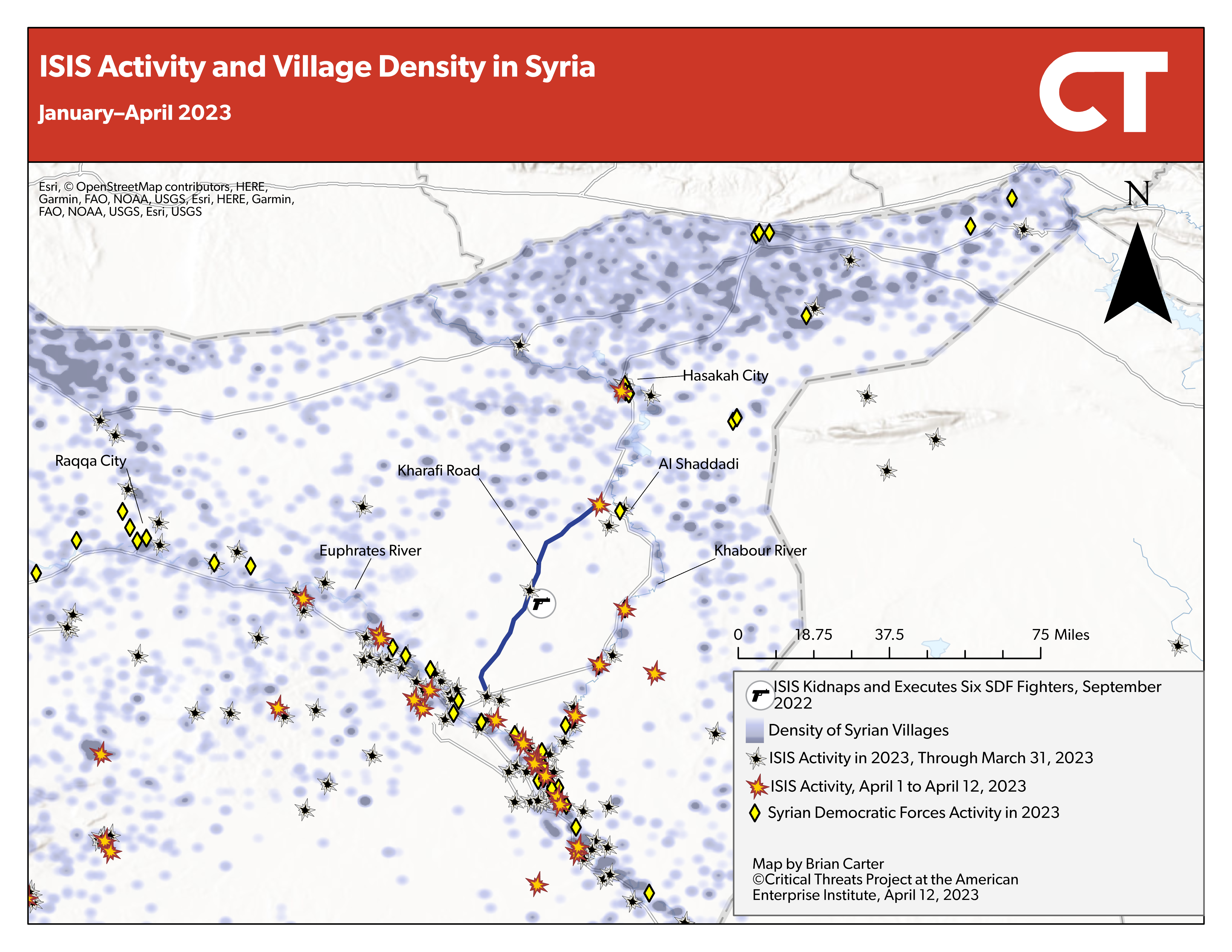
Note: Some of the locations on this map are approximate. CTP defines “attacks” as kinetic activity, including assassinations, armed assaults on military positions, executions, and bombings. “Activity” includes all forms of ISIS activity, including attacks, force movements, and reports of governance activity like zakat collection. ISIS does not generally report on these non-kinetic activities and does not claim all of its attacks.
Source: Brian Carter and Bucknell University.
ISIS blocking operations likely enable the group to use rural areas in northeastern Syria to launch its attacks.[iii] Some SDF commanders told the International Crisis Group that ISIS uses parts of rural northeastern Syria as a “storehouse” for supplies for its operations.[iv] ISIS uses both improvised explosive device (IED) and small-arms attacks to block SDF patrols from penetrating these areas.[v] The SDF’s inability to dislodge ISIS from rural areas indicates ISIS can reconstitute its support structures in those areas. For example, the SDF captured a major ISIS supply depot in Hasakah province in September 2022, but it launched a second operation that arrested dozens of alleged ISIS fighters in the same area in December 2022.[vi]
ISIS also degrades SDF GLOCs to disrupt SDF counterinsurgency operations along the Euphrates River and in the rural areas between the Kharafi Road and Khabour River. ISIS propaganda said in February 2022 that recent attacks created “death and terror” on the Kharafi Road connecting Hasakah city and Deir ez Zor.[vii]
ISIS cells simultaneously suppress SDF forces in the Euphrates River Valley to maintain ISIS GLOC that cross the Euphrates River and enable ISIS to move forces and supplies to and from northeastern Syria.[viii] The SDF frequently attempts to disrupt smuggling.[ix] These anti-smuggling operations require an ISIS response to maintain ISIS GLOC. ISIS frequently targets SDF patrols close to the Euphrates River in Deir ez Zor and Raqqa provinces.[x]
ISIS neutralizes SDF units to challenge the SDF’s control of urban and semi-urban areas while gradually expanding ISIS’s control over the population.[xi] ISIS’s blocking, interdiction, and suppression operations enable ISIS raids and neutralization efforts near population centers by providing logistical and administrative support while degrading the SDF’s support functions.[xii] ISIS neutralizes the SDF by fixing SDF forces, eliminating leadership, undermining SDF force generation, and targeting SDF patrols with IEDs and small arms to discourage them from conducting effective counterinsurgency.[xiii] This renders the SDF unable to accomplish their mission of defeating ISIS and enables further ISIS operations.
Finally, ISIS launches raids from rural areas. These raids aim to showcase ISIS’s strength to prospective recruits while undermining the SDF’s ability to recruit new members.[xiv] ISIS propaganda supports and encourages additional ISIS attacks by amplifying successful attacks. ISIS raided an SDF Internal Security Forces headquarters in Raqqa in December 2022, for example.[xv] ISIS emphasized in its propaganda the damage the attack caused, its focus on freeing imprisoned ISIS members, and its strength.[xvi]
Iran and Syrian regime-backed campaigns overlap with this ISIS campaign, suppressing US and SDF forces.[xvii] Iranian and regime-backed attacks against SDF and US forces impose bandwidth constraints on both the United States and the SDF. The United States chooses to redirect intelligence, surveillance, and reconnaissance assets devoted to the counter-ISIS fight to target Iran-backed actors in response to these attacks. The United States responded to an Iran-backed militia attack against US forces with an airstrike on April 10 in Deir ez Zor.[xviii] Diverting attention and resources to Iran-backed militias could temporarily constrain US-supported SDF counter-ISIS operations.
Turkey. The Iraqi government and anonymous Western officials said that Turkey conducted a drone strike targeting SDF Commander Mazloum Abdi and Syrian Democratic Council leader Ilham Ahmed on April 7 in Sulaymaniyah, Iraq.[xix] US personnel were in Abdi’s vehicle.[xx] Abdi and the SDF are the principal US counter-ISIS partner in Syria. The Patriotic Union of Kurdistan, which controls Sulaymaniyah and works closely with the United States and SDF, condemned the drone strike but did not name the perpetrator.[xxi]
Abdi said on April 8 that this is the second Turkish assassination attempt against him since November, when another Turkish strike targeted Abdi at his Hasakah headquarters.[xxii] The US Defense Department condemned the November strike without naming Turkey, citing a risk to US personnel.[xxiii]
Turkey’s attacks create additional challenges for the SDF in defeating ISIS. The United States withdrew its forces from some SDF-controlled areas to avoid force protection concerns during the 2019 Turkish incursion.[xxiv] The SDF relies on US support to fulfill key functions enabling the force to defeat ISIS.[xxv] Abdi and his senior advisers frequently prioritize the Turkish threat over ISIS.[xxvi]
Figure 2. The Salafi-Jihadi Movement in the Middle East
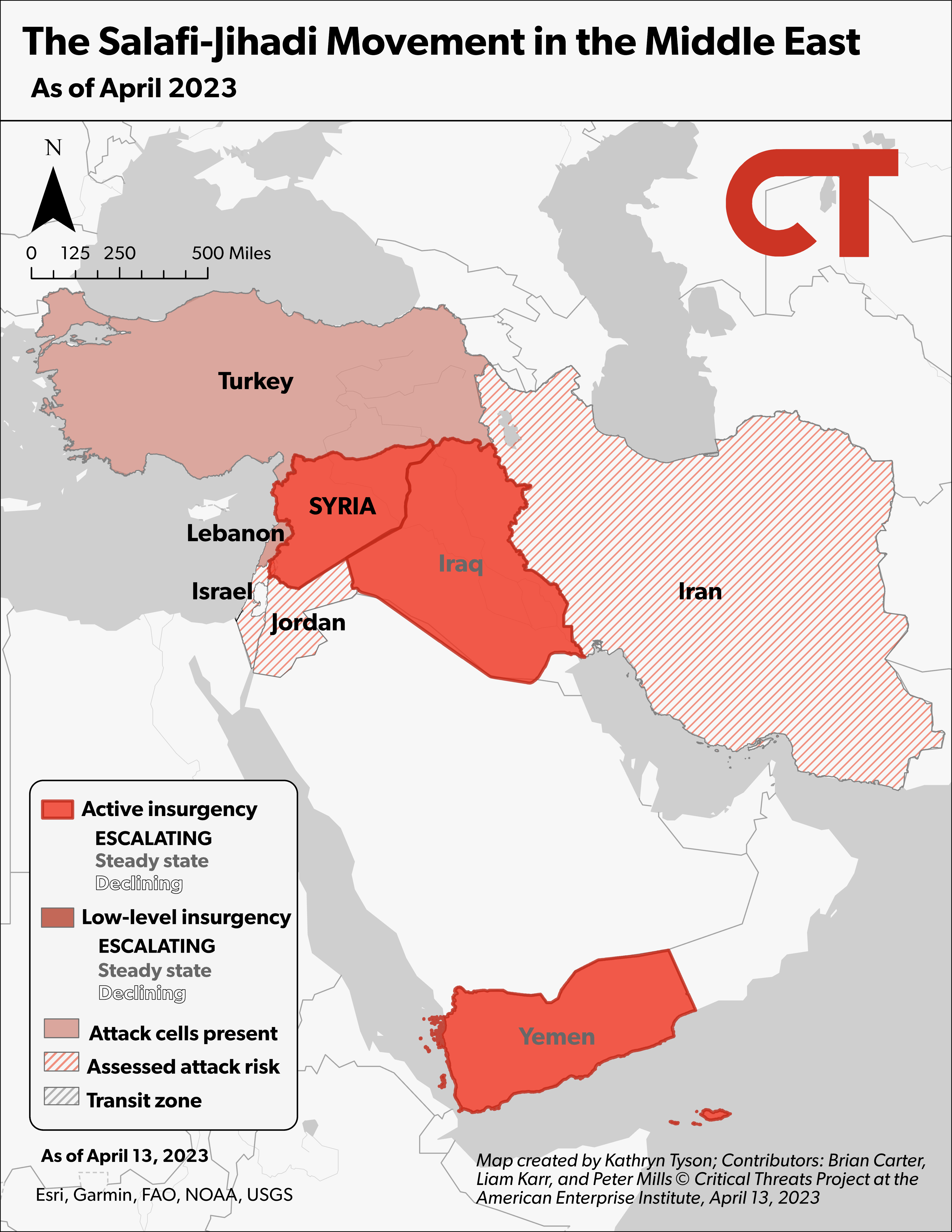
Source: Kathryn Tyson.
Somalia.
The SFG’s inability to escalate on multiple fronts against al Shabaab could allow the group to repel renewed Somali offensive operations in central Somalia. The SFG began the renewed offensive against al Shabaab in central Somalia by reentering the town of Gal’ad and the surrounding area in late March and early April.[xxvii] Somali forces liberated Gal’ad in January, but al Shabaab overran their base. This attack halted the first phase of the SFG campaign and caused a three-month pause in operations.[xxviii] Al Shabaab has not contested the April operations directly, but it did launch two large-scale attacks on nearby Somali bases on March 21 and April 4.[xxix]
Figure 3. Somali Forces and al Shabaab Contest the Galgudud Region
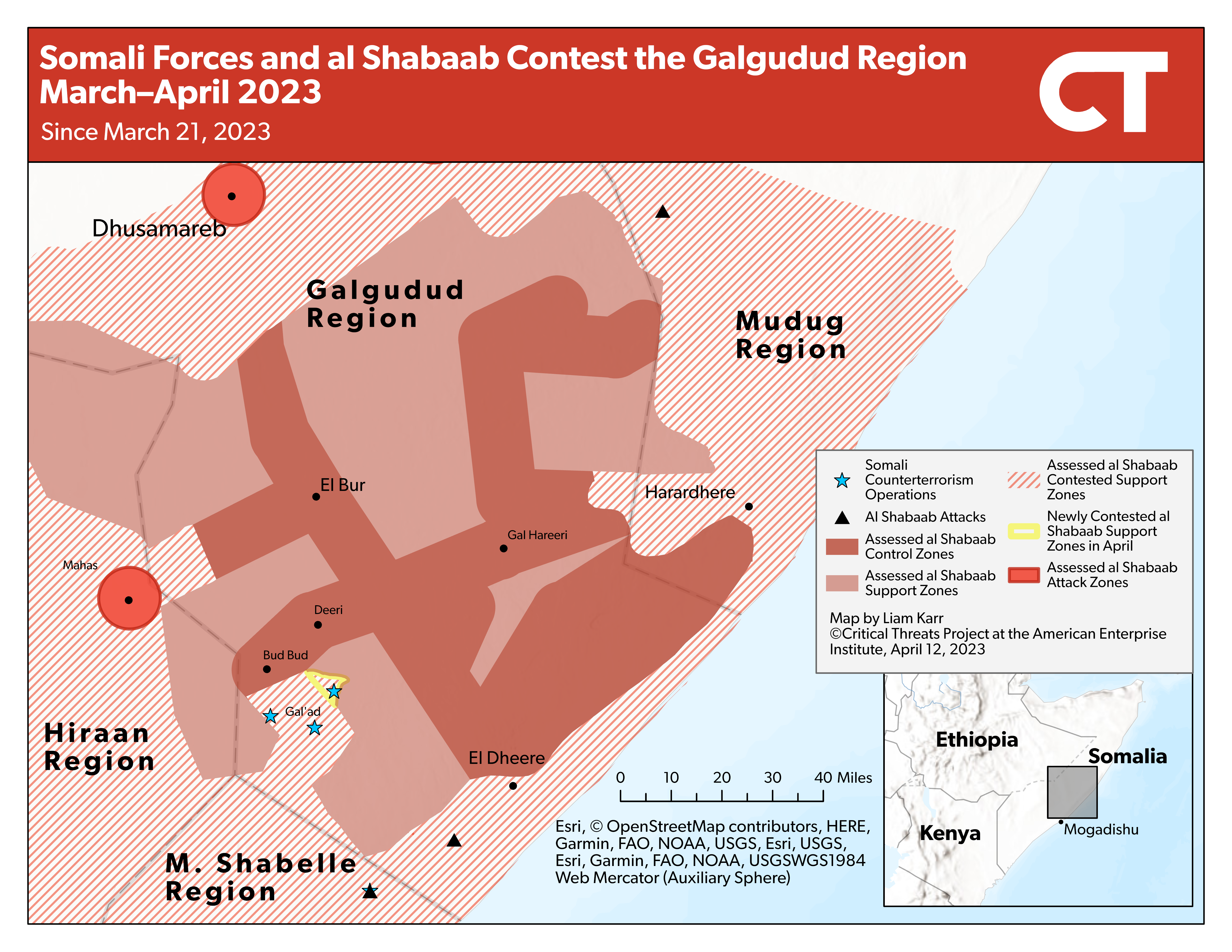
Source: Liam Karr.
Somali forces will likely use Gal’ad as a base to launch operations toward the remaining al Shabaab strongholds in the Galgudud region. Gal’ad is 50 miles south of El Bur and roughly 55 miles from Gal Hareeri, the two largest remaining al Shabaab–controlled towns in the Galgudud region.[xxx] Somali forces moving north into the areas of Bud Bud or Derri would signal that Somali forces are escalating operations toward these al Shabaab strongholds in the El Bur district instead of consolidating their position in Gal’ad and the El Dheere district.
Somali forces have not sustained other fronts in central Somalia, which will allow al Shabaab to target the forces operating from Gal’ad. Operations pressuring El Bur from the north, east, and west have stagnated since the first phase of the offensive escalated in September 2022 due to insufficient local support.[xxxi] Al Shabaab negotiated deals with the dominant clans in some of these areas, causing local militias to stop working with the SFG.[xxxii] Locals stopped supporting the offensive on other axes after their leaders disagreed with their federal counterparts on drone-strike usage and distrusted government support for their intra-clan rivals in the area. Local militias have remained active around Gal’ad, likely enabling the resumption of operations. The lack of pressure on other axes will allow al Shabaab to concentrate against Somali forces operating out of Gal’ad as it did in January.[xxxiii] Somali forces in the Harardhere district that paused operations in February 2023 may be another potential option for the SFG to open a second front.[xxxiv]
The SFG reestablishing local support along any of the stagnated axes could help it resume operations against al Shabaab in those areas. Local militias have been a key enabler of the SFG offensive in central Somalia.[xxxv] SFG officials meeting with local elders could indicate it is making inroads around Galgudud. Al Shabaab has also retaliated against civilians and villages from clans that cooperate with the SFG, so al Shabaab punitive attacks against villagers is another indicator that the SFG may have regained local support in some areas of Galgudud.[xxxvi]
Somali forces have not expanded operations against al Shabaab in southern Somalia, which would preoccupy al Shabaab forces there and degrade the group’s ability to move militants in support of its forces in central Somalia. Somali forces have increased operations in southern Somalia since January 2023, but they have likely delayed expanding their activity away from previously contested areas and into al Shabaab support zones due to seasonal flooding and limited forces from regional partners.[xxxvii] The lack of pressure in southern Somalia will allow al Shabaab to reinforce central Somalia by sending fighters from the south while rotating wounded soldiers to its control zones in southern Somalia through its rural support and contested support zones throughout the country.[xxxviii]
The arrival of Djiboutian or Kenyan troops in Somalia could enable the SFG to escalate operations in southern or central Somalia. Djibouti, Ethiopia, and Kenya agreed to send non–African Union troops to participate in offensive operations in Somalia in January 2023, but only Ethiopian troops have arrived so far.[xxxix] The Somali national security adviser said in an interview in early March that these forces would arrive in Somalia by the end of April.[xl] It is unclear if these troops will deploy entirely to southern Somalia or deploy to the same areas as their African Union compatriots, which would send Djiboutian forces to central Somalia.[xli] The SFG is likely relying on these troops to compensate for the lack of effective or cooperative militia forces in parts of southern and possibly central Somalia.[xlii]
Al Shabaab Global Operations. Costa Rican police arrested the son of senior al Shabaab Commander Fuad Shongole on April 10.[xliii] Costa Rican authorities plan to transfer Farah to Somali authorities.[xliv] Shongole has been a part of al Shabaab since its formation in the mid-2000s and serves on its Shura Council. Shongole also is a specially designated national with a $5 million bounty from the US State Department.[xlv]
Shongole’s son, Lutran Farah, entered Costa Rica under a false alias in January and temporarily crossed into Nicaragua in February.[xlvi] The FBI warned Costa Rican authorities that a potential al Shabaab member was in the country in February and said the individual was on the FBI’s Terrorist Screening Center watch list.[xlvii]
Farah was likely trying to carry out an attack in the US. Al Shabaab has tried to orchestrate attacks on the US mainland as recently as 2019.[xlviii] Farah’s travel north into Nicaragua indicates he was attempting to find a route into the United States across the southern border. Farah alternatively may have been trying to set up funding networks in Latin America or the US. Al Qaeda had funding cells in parts of South and Central America during the early 2000s. However, CTP lacks indications al Shabaab has done so.[xlix] Al Shabaab also has robust taxation, extortion, and illicit trade systems in Somalia that it can more easily increase revenue from.[l] Farah was not fleeing al Shabaab, given his use of a false alias and failure to claim asylum.
Figure 4. The Salafi-Jihadi Movement in Africa
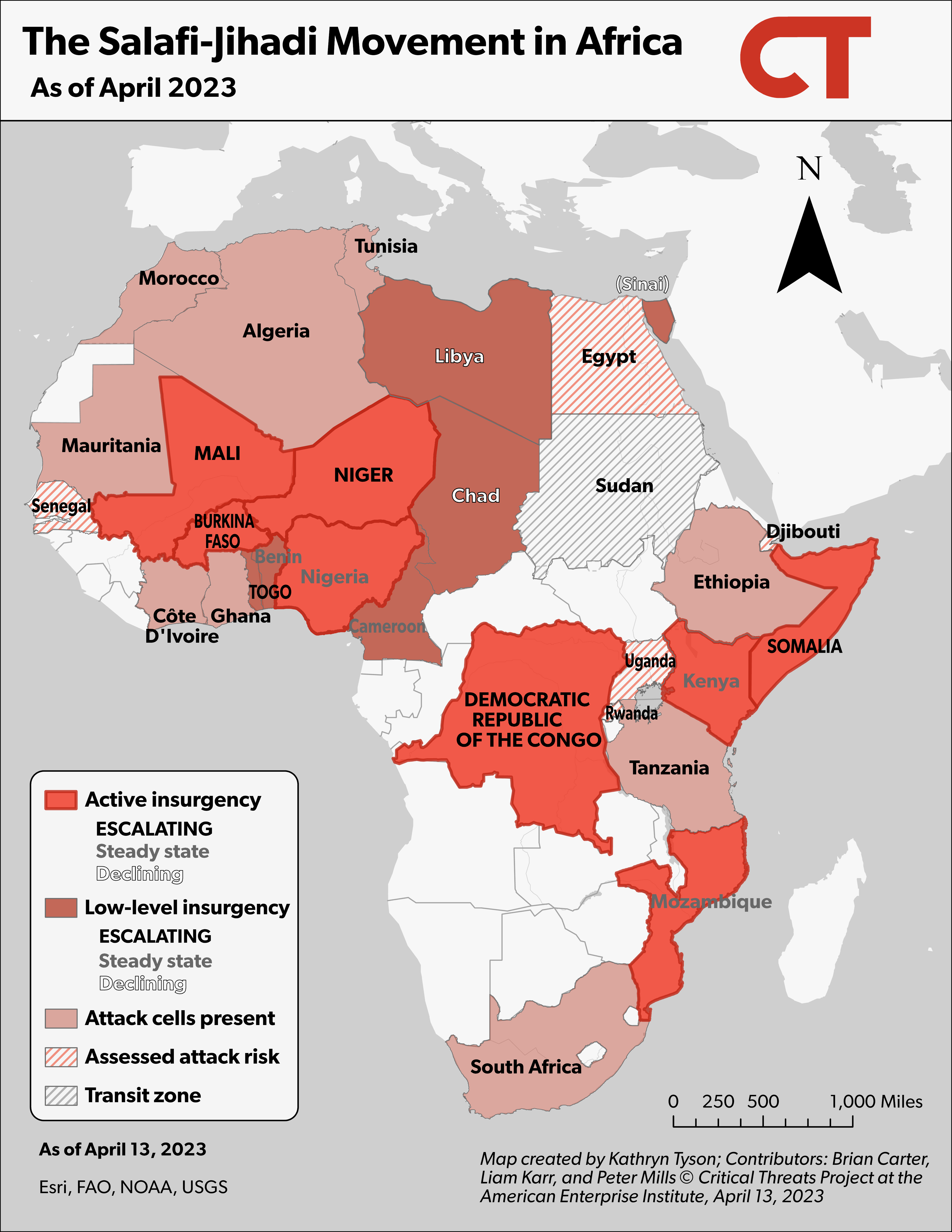
Source: Kathryn Tyson.
Pakistan.
The Pakistani military may begin preparations for a large-scale counterterrorism campaign against the TTP in the next two weeks. High-level Pakistani political and military leaders agreed on April 7 to launch a nationwide counterterrorism offensive against militants coming to Pakistan from Afghanistan.[li] The plan will likely target the TTP, which has safe havens in Afghanistan and has expanded attacks in Pakistan since ending a cease-fire with the Pakistani government in November 2022.[lii] The session was a continuation of a meeting discussing a major TTP bombing in Peshawar in January 2023.[liii] Pakistani leadership also said it would relaunch an action plan that the government created in 2014 as part of a nationwide counter-TTP campaign.[liv] Leadership announced it would form another committee to submit recommendations on the parameters of the operation by April 21.
Figure 5. TTP Attacks and Pakistani Operations Against the TTP
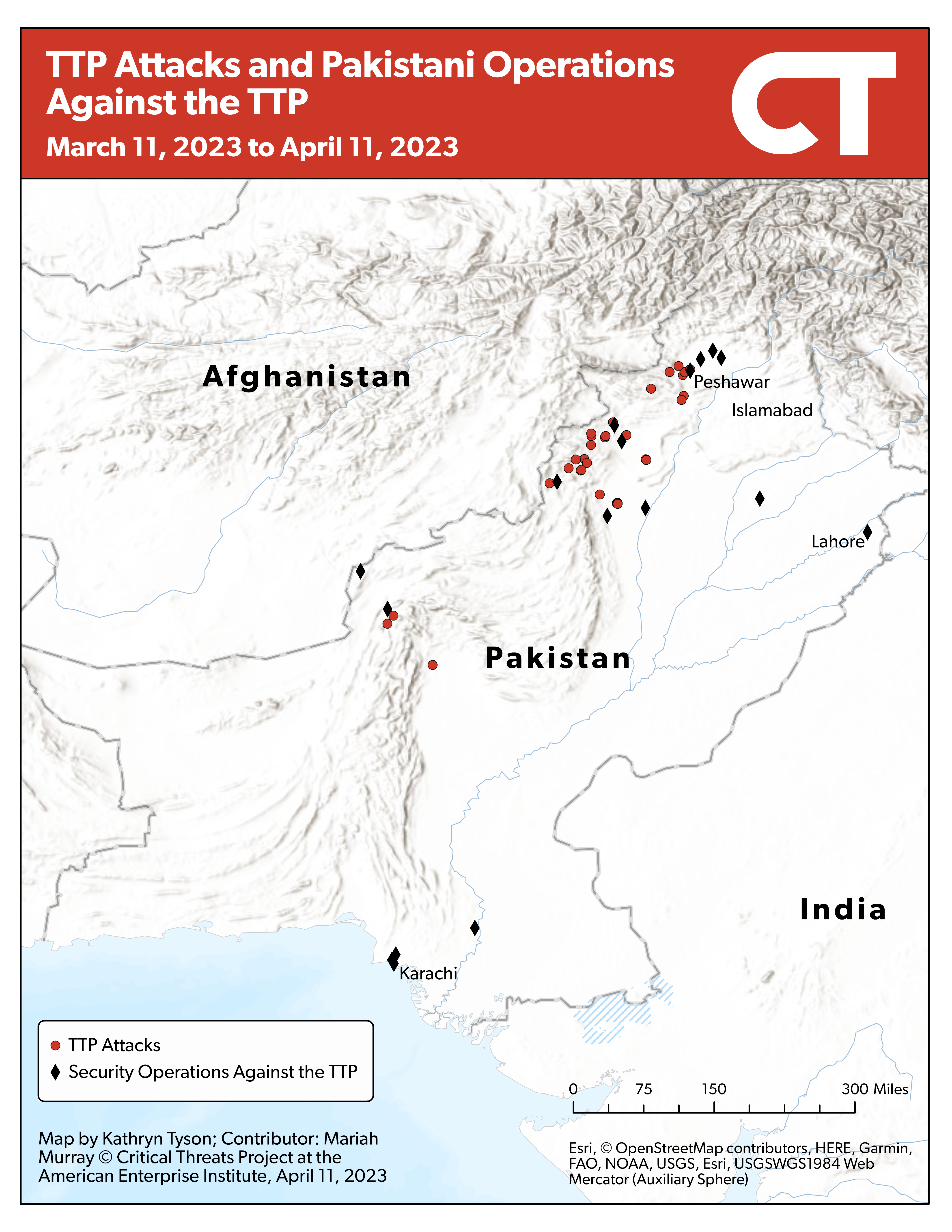
Source: Kathryn Tyson.
The Pakistani military distributed leaflets on April 7 saying it would carry out large-scale counter-TTP operations in North and South Waziristan, though CTP cannot independently verify this information.[lv] The leaflets indicated Pakistani security forces would conduct these operations by temporarily displacing tribes and establishing additional checkpoints in these regions.
A counter-TTP campaign now is unlikely to model previous large-scale Pakistani military campaigns that contained the TTP from 2007 to 2009 and in 2014. The United States no longer has a physical presence in Afghanistan, and it does not conduct air strikes and covert operations in Pakistan. The US has supported previous counter-TTP military campaigns by striking senior TTP leadership and training Pakistani security forces.[lvi] The TTP is also not as geographically concentrated—nor does it control swaths of territory—as in 2014 in North and South Waziristan, which may make it more difficult for the Pakistani military to effectively locate and target groups of fighters.[lvii]
Afghan Taliban control of Afghanistan may hinder Pakistan’s ability to successfully carry out a counter-TTP campaign. Pakistan has not launched a campaign against the TTP while the Afghan Taliban have been in power. Afghan Taliban leadership would likely not support a full-scale campaign targeting the TTP, particularly in Waziristan. The Haqqani Network, a branch of the Afghan Taliban, has long-standing bases in Waziristan. Pakistan would likely go out of its way to avoid targeting members of the Haqqani Network, which has served as a Pakistani state proxy and played a mediating role between Pakistan and the TTP during peace talks in 2022.[lviii] With the Taliban now in power, TTP members escaping the operation may be able to reconstitute in Afghanistan unhindered.
Political conditions in Pakistan may also complicate preparations for a military offensive. Pakistani leadership blamed the spread of the TTP on policies by former Pakistani Prime Minister Imran Khan.[lix] Political opponents and members of Khan’s party have accused the current Pakistani government of announcing the campaign now to prevent early elections, which Khan has pushed.[lx] Politicization could weaken public support of the operation from supporters of Khan and his party.
Afghanistan.
Taliban security forces are trying to disrupt ISKP’s GLOC into Iran. Taliban security forces conducted raids on April 3 and 8 targeting ISKP cells in Zaranj, Nimroz Province.[lxi] Zaranj serves as a major hub for smuggling people and drugs into neighboring Iran and Pakistan.[lxii] Some of these ISKP cells were located close to the local Taliban intelligence headquarters.[lxiii] The raid on April 3 sparked major fighting, which caused more than a dozen Taliban casualties.[lxiv] The presence of ISKP cells close to this headquarters and the heavy fighting that followed the raid could indicate the Taliban perceive a greater threat from ISKP in the area. Alternatively, the Taliban could be giving priority to ISKP networks that threaten Iran in exchange for improving trade ties with Iran.
ISKP may have used its networks in Zaranj to maintain GLOC into Iran since at least 2021. The US Treasury Department designated an ISKP member in November 2021 who reportedly smuggled individuals from Afghanistan to Turkey.[lxv] The primary human smuggling networks connecting Turkey and Afghanistan run through Iran.[lxvi] Taliban intelligence arrested an ISKP militant in northern Afghanistan who was involved in smuggling ISKP members and weapons between Afghanistan and Iran in August 2022.[lxvii] The Taliban arrested another ISKP militant in October 2022 who used ISKP networks in Zaranj to transit between Afghanistan and Iran.[lxviii]
The Taliban’s focus on dismantling ISKP networks near the border with Iran may reflect growing cooperation between the Taliban government and Iran. Iran handed over the Afghanistan embassy in Tehran to Taliban-appointed diplomatic representatives in February 2023.[lxix] The Taliban commerce minister met with the Iranian governors of Khorasan and Sistan-Balochistan Provinces and the Iranian trade minister in mid-March to discuss trade between Iran and Afghanistan.[lxx] Iranian Ambassador to Afghanistan Kazemi Qomi called the talks fruitful and said that Iran and the Taliban were discussing ways to increase trade between Iran’s Chabahar Port and Afghanistan.[lxxi] Qomi previously advocated for greater security cooperation with the Taliban to counter ISKP. Iran may condition closer relations with the Taliban on the Taliban giving priority to degrading ISKP networks along Afghanistan-Iran border.
Figure 6. The Salafi-Jihadi Movement in Central and South Asia
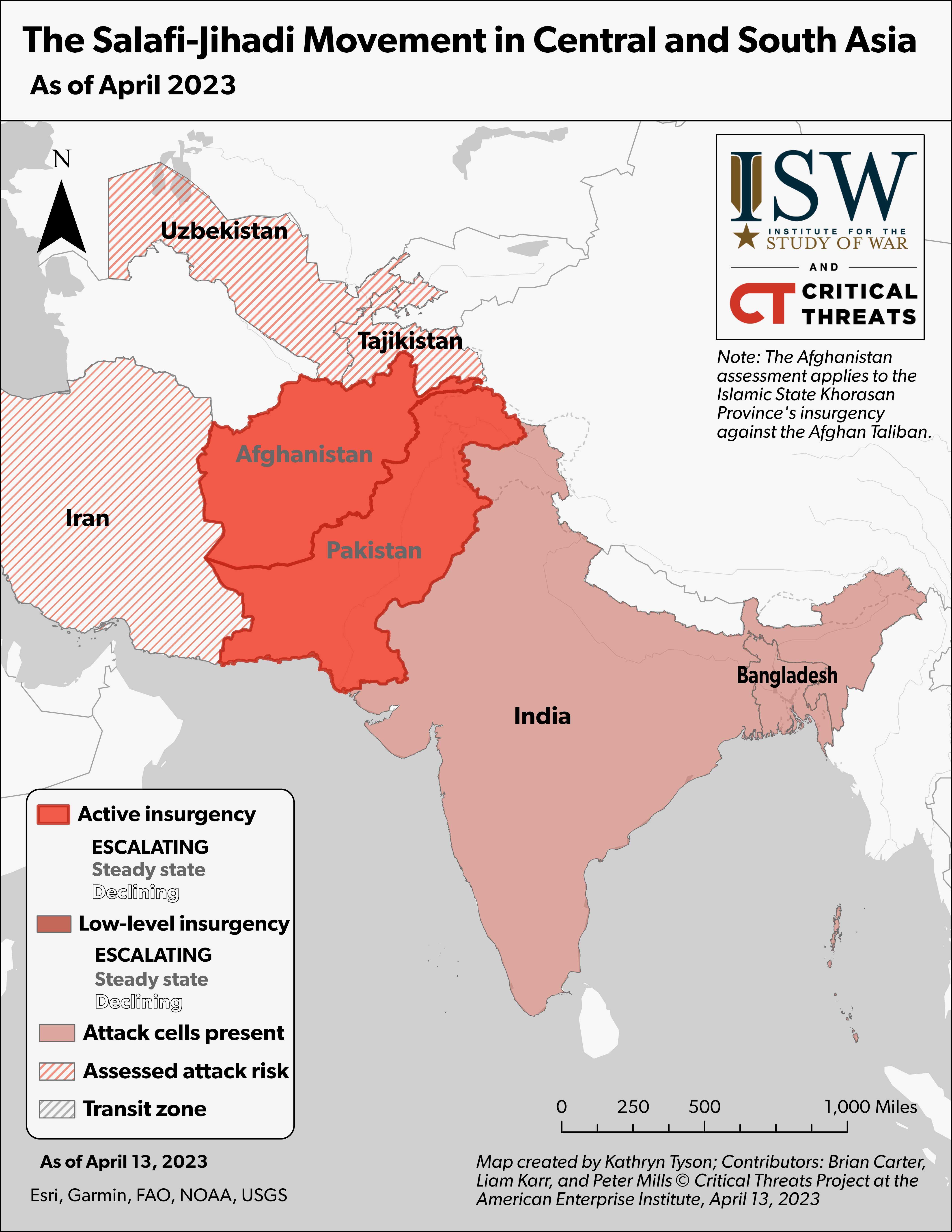
Source: Kathryn Tyson.
[i] https://www.aymennjawad.org/2018/12/islamic-state-insurgent-tactics-translation-1; https://aymennjawad.org/2019/05/the-islamic-state-portrait-of-its-current-strategy
[ii] Author’s research; https://www.aymennjawad.org/2019/04/islamic-state-insurgent-tactics-translation; https://www.aymennjawad.org/2018/12/islamic-state-insurgent-tactics-translation-1; https://www.aymennjawad.org/2019/05/islamic-state-insurgent-tactics-translation-2; https://www.aymennjawad.org/2019/05/islamic-state-insurgent-tactics-translation-3, https://kyleorton.co.uk/2022/08/16/the-strategic-plan-of-the-islamic-state; https://kyleorton.co.uk/2022/09/01/al-naba-349-interview-islamic-state-insurgency-badiya-desert
[iii] The US Army defines “block” as “a tactical mission task that denies the enemy access to an area or prevents the enemy’s advance in a direction or along an avenue of approach.” See https://armypubs.army.mil/epubs/DR_pubs/DR_a/NOCASE-FM_3-90-1-002-WEB-6.pdf
[iv] https://www.crisisgroup.org/middle-east-north-africa/east-mediterranean-mena/syria/containing-resilient-isis-central-and-north
[v] Author’s research. Source for ISIS claims available on request.
[vi] https://twitter.com/DeirEzzore/status/1608431882798088193; https://sdf-press dot com/?p=39211; https://www.hawarnews dot com/ar/haber/qsd-tdhbt-akbr-mkhba-slah-ldaash-bad-mkhba-albaghwz-wtfshl-mkhtt-22irhaby22-khtyr-h71623.html
[vii] https://jihadology.net/2023/02/10/new-issue-of-the-islamic-states-newsletter-al-naba-377
[viii] https://www.crisisgroup.org/middle-east-north-africa/east-mediterranean-mena/syria/containing-resilient-isis-central-and-north; The US Army defines suppress as “a tactical mission task that results in the temporary degradation of the performance of a force or weapon system below the level needed to accomplish its mission,” https://armypubs.army.mil/epubs/DR_pubs/DR_a/NOCASE-FM_3-90-1-002-WEB-6.pdf.
[ix] https://npasyria dot com/127508
[x] Author’s research. Sources available on request.
[xi] The US Army defines “neutralize” as a “tactical mission task that results in rendering enemy personnel or materiel incapable of interfering with a particular operation” until reconstituted. https://armypubs.army.mil/epubs/DR_pubs/DR_a/NOCASE-FM_3-90-1-002-WEB-6.pdf
[xii] The US Army defines interdicting as ”a tactical mission task where the commander prevents, disrupts, or delays the enemy’s use of an area or route,” https://armypubs.army.mil/epubs/DR_pubs/DR_a/NOCASE-FM_3-90-1-002-WEB-6.pdf.
[xiii] Author’s research. Sources for ISIS claims available on request; https://www.iswresearch.org/2020/08/anti-isis-coalition-begins-losing.html; https://cadmus.eui.eu/handle/1814/74418
[xiv] https://www.criticalthreats.org/analysis/ending-the-us-presence-in-syria-could-cause-a-rapid-isis-reconstitution-and-threaten-core-us-national-security-interests; https://www.aymennjawad.org/2019/04/islamic-state-insurgent-tactics-translation; https://www.aymennjawad.org/2018/12/islamic-state-insurgent-tactics-translation-1; https://www.aymennjawad.org/2019/05/islamic-state-insurgent-tactics-translation-2; https://www.aymennjawad.org/2019/05/islamic-state-insurgent-tactics-translation-3
[xv] Source for ISIS claim available on request.
[xvi] Source for ISIS claim available on request.
[xvii] The US Army defines “suppress” as “a tactical mission task that results in the temporary degradation of the performance of a force or weapon system below the level needed to accomplish its mission.” For definitions of tactical mission tasks, see pages 256–60 in https://armypubs.army.mil/epubs/DR_pubs/DR_a/NOCASE-FM_3-90-1-002-WEB-6.pdf
[xviii] https://www.criticalthreats.org/analysis/iran-update-april-11-2023; https://www.inherentresolve.mil/NEWSROOM/News-Articles/Stories-Display/Article/3357442/cjtf-oir-commander-condemns-attack-in-deir-ez-zor-syria
[xix] https://www.wsj.com/articles/drone-strike-in-iraq-targets-syrian-kurdish-leader-a-u-s-ally-a567055a; https://www.al-monitor.com/originals/2023/04/drone-strike-targets-us-syrian-kurdish-ally-mazlum-kobane-turkey-suspected
[xx] https://www.wsj.com/articles/drone-strike-in-iraq-targets-syrian-kurdish-leader-a-u-s-ally-a567055a
[xxi] https://twitter.com/Bafeltalabani/status/1644439781856669759?s=20
[xxii] https://al-monitor.com/originals/2023/04/us-backed-syrian-kurdish-leader-mazlum-kobane-says-turkeys-attempt-life-not-first#ixzz7yJzZdvHu; https://www.al-monitor.com/originals/2023/04/drone-strike-targets-us-syrian-kurdish-ally-mazlum-kobane-turkey-suspected
[xxiii] https://www.reuters.com/world/middle-east/turkish-air-strikes-syria-threatened-safety-us-personnel-pentagon-2022-11-23; https://www.defense.gov/News/Releases/Release/Article/3227725/dod-statement-on-escalating-actions-in-iraq-syria-and-turkey
[xxiv] https://www.bbc.com/news/world-middle-east-49960973; https://www.nbcnews.com/news/world/turkey-launches-operation-syria-3-days-after-trump-announces-u-n1063576; https://www.cbsnews.com/news/syria-withdrawal-lindsey-graham-blasts-us-withdrawing-troops-northern-syria-posts-2019-10-07; https://www.defense.gov/News/News-Stories/Article/Article/1987962/esper-condemns-turkeys-syria-incursion-says-us-stands-with-syrian-democratic-fo
[xxv] https://www.criticalthreats.org/analysis/ending-the-us-presence-in-syria-could-cause-a-rapid-isis-reconstitution-and-threaten-core-us-national-security-interests
[xxvi] https://www.criticalthreats.org/analysis/ending-the-us-presence-in-syria-could-cause-a-rapid-isis-reconstitution-and-threaten-core-us-national-security-interests
[xxvii] https://twitter.com/HarunMaruf/status/1644273321586876419?s=20; https://sonna dot so/en/somali-army-repulses-terrorist-militants-takes-control-new-area; https://goobjoog dot com/english/somali-army-conducts-operation-at-galgaduud-city
[xxviii] https://www.criticalthreats.org/analysis/salafi-jihadi-movement-weekly-update-january-25-2023; https://www.crisisgroup.org/africa/horn-africa/somalia/b187-sustaining-gains-somalias-offensive-against-al-shabaab
[xxix] https://radioalfurqaan dot com/2023/03/faahfaahin-khasaarihii-ka-dhashay-weerarkii-saaka-ee-daaru-nicma-oo-sii-kordhay; https://sonna dot so/en/army-official-over-30-al-shabaab-terrorist-militants-killed-in-military-operation; https://www.caasimada dot net/al-shabaab-oo-weerar-ku-qaaday-xero-ku-taalla-ruun-nirgood-khasaaraha
[xxx] https://www.criticalthreats.org/analysis/salafi-jihadi-movement-weekly-update-january-18-2023; https://www.crisisgroup.org/africa/horn-africa/somalia/b187-sustaining-gains-somalias-offensive-against-al-shabaab
[xxxi] https://www.caasimada dot net/sawirro-ciidanka-duulaanka-ku-ah-ceelbuur-oo-deegaan-muhiim-ah-qabsaday-shalay; https://en.halbeeg dot com/2022/10/25/sna-forces-recapture-small-town-in-central-somalia; https://goobjoog dot com/english/sna-troops-drive-out-khawarij-militants-from-whabo-town-ending-a-15-year-siege; https://radiorisaala dot com/howlgallo-ka-socda-degaano-ka-kala-tirsan-gobolada-hiiraan-mudug
[xxxii] https://www.garoweonline dot com/en/news/somalia/somalia-detains-elders-over-links-to-al-shabaab; https://www.crisisgroup.org/africa/horn-africa/somalia/b187-sustaining-gains-somalias-offensive-against-al-shabaab
[xxxiii] https://www.criticalthreats.org/briefs/gulf-of-aden-security-review/gulf-of-aden-security-review-january-20-2023
[xxxiv] https://twitter.com/sntvnews1/status/1625097935812718595?s=20&t=ZCkn3gXLRnso_eMw2ptM0g
[xxxv] https://www.criticalthreats.org/briefs/africa-file/africa-file-clan-uprising-bolsters-anti-al-shabaab-offensive-in-central-somalia; https://www.crisisgroup.org/africa/horn-africa/somalia/b187-sustaining-gains-somalias-offensive-against-al-shabaab
[xxxvi] https://www.criticalthreats.org/briefs/africa-file/africa-file-clan-uprising-bolsters-anti-al-shabaab-offensive-in-central-somalia; https://www.criticalthreats.org/briefs/gulf-of-aden-security-review/gulf-of-aden-security-review-january-9-2023; https://www.hiiraan dot com/news4/2023/Apr/190802/heavy_rains_in_ethiopia_raise_water_levels_prompting_flood_warnings_in_somalia.aspx
[xxxvii] https://www.criticalthreats.org/analysis/salafi-jihadi-movement-weekly-update-march-8-2023; https://www.criticalthreats.org/analysis/salafi-jihadi-movement-weekly-update-march-29-2023
[xxxviii] https://www.crisisgroup.org/africa/horn-africa/somalia/b187-sustaining-gains-somalias-offensive-against-al-shabaab
[xxxix] https://www.voanews.com/a/somalia-s-neighbors-to-send-additional-troops-to-fight-al-shabab-/6986748.html; https://www.garoweonline dot com/en/news/somalia/ethiopia-sends-non-atmis-troops-to-somalia-in-fight-against-al-shabaab; https://shabellemedia dot com/ethiopia-deployed-non-atmis-troops-to-somalia
[xl] https://www.voanews.com/a/somalia-s-neighbors-to-send-additional-troops-to-fight-al-shabab-/6986748.html
[xli] https://atmis-au.org/military-component
[xlii] https://www.criticalthreats.org/analysis/salafi-jihadi-movement-weekly-update-march-8-2023; https://www.crisisgroup.org/africa/horn-africa/somalia/b187-sustaining-gains-somalias-offensive-against-al-shabaab
[xliii] https://ticotimes dot net/2023/04/09/son-of-al-shabaab-leader-arrested-and-deported-from-costa-rica
[xliv] https://ticotimes dot net/2023/04/09/son-of-al-shabaab-leader-arrested-and-deported-from-costa-rica
[xlv] https://www.criticalthreats.org/analysis/profile-fuad-mohamed-qalaf-shongole
[xlvi] https://ticotimes dot net/2023/04/09/son-of-al-shabaab-leader-arrested-and-deported-from-costa-rica
[xlvii] https://ticotimes dot net/2023/04/09/son-of-al-shabaab-leader-arrested-and-deported-from-costa-rica
[xlviii] https://www.justice.gov/opa/pr/kenyan-national-indicted-conspiring-hijack-aircraft-behalf-al-qaeda-affiliated-terrorist
[xlix] https://www.jstor.org/stable/26482884; https://smallwarsjournal.com/documents/abbott.pdf
[l] https://home.treasury.gov/news/press-releases/jy1028
[li] https://www.reuters.com/world/asia-pacific/pakistan-launch-new-military-operation-against-islamist-militants-statement-2023-04-07; https://www dot geo.tv/latest/480777-pm-shehbaz-sharif-to-chair-nsc-meeting-today-to-discuss-ongoing-situation
[lii] https://www.aljazeera.com/news/2022/11/28/pakistan-taliban-ends-ceasefire-with-govt-threatens-new-attacks
[liii] https://www.criticalthreats.org/analysis/salafi-jihadi-movement-weekly-update-february-1-2023
[liv] https://www dot dawn dot com/news/1746510/elections-seem-less-likely-as-nsc-announces-anti-terror-operations
[lv] https://twitter.com/SaleemMehsud/status/1645749464336834561
[lvi] https://www.theguardian.com/world/2009/aug/07/taliban-leader-baitullah-mehsud-killed; https://www.cfr.org/backgrounder/us-pakistan-military-cooperation; https://abcnews.go.com/International/us-military-die-pakistan-bombing/story?id=9734681
[lvii] https://ctc.westpoint.edu/the-revival-of-the-pakistani-taliban
[lviii] https://www.criticalthreats.org/analysis/what-you-need-to-know-about-pakistans-north-waziristan-operation; https://www.voanews.com/a/pakistan-militants-pause-afghan-hosted-peace-talks-for-internal-discourse-amid-cautious-optimism-/6595633.html
[lix] https://twitter.com/IftikharFirdous/status/1644375774936596481
[lx] https://www dot dawn dot com/news/1746510/elections-seem-less-likely-as-nsc-announces-anti-terror-operations
[lxi] https://twitter.com/abdsayedd/status/1643003300072103937; https://www.rferl.org/a/afghanistan-islamic-state-khorasan-raid-taliban/32356118.html; https://twitter.com/AfghanAnalyst2/status/1644910476067831809
[lxii] https://www.rferl.org/a/afghanistan-people-smuggling-taliban-bribes/31872064.html; https://www.france24.com/en/live-news/20220309-freedom-s-choice-for-afghans-over-the-wall-or-through-the-desert
[lxiii] https://twitter.com/bsarwary/status/1643045799759052802
[lxiv] https://twitter.com/bsarwary/status/1643341756191088642
[lxv] https://home.treasury.gov/news/press-releases/jy0502
[lxvi] https://www.dw.com/en/smuggling-people-from-afghanistan-to-turkey/a-58981207
[lxvii] https://twitter.com/GDI1415/status/1555047905580425221
[lxviii] https://twitter.com/GDI1415/status/1576803442127142913
[lxix] https://www.voanews.com/a/iran-hands-over-afghan-embassy-in-tehran-to-taliban-/6980784.html; https://www.washingtoninstitute.org/policy-analysis/iran-formalizes-ties-taliban
[lxx] https://twitter.com/TOLOnews/status/1636300881426542595; https://twitter.com/Shamshadnetwork/status/1635983938186297345; https://twitter.com/MoICAfghanistan/status/1636728536017821696
[lxxi] https://twitter.com/TOLOnews/status/1636300881426542595
